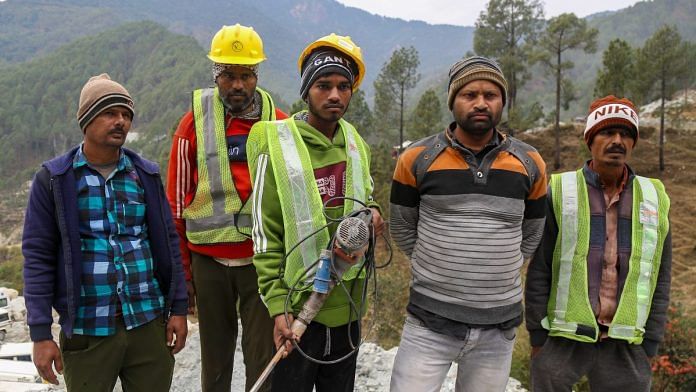As rescue operations picked pace following the Uttarkashi tunnel collapse on 12 November, which trapped 41 workers, the authorities brought in excavator machines to dig the debris that had blocked the tunnel.
But soon came the realisation that the machines were not enough. They needed more ammo for drilling through the rock and boulder-mixed debris. After a round of brainstorming among the officials of different agencies involved in the rescue operations, the decision was made to use the 500-tonne capacity auger drilling machine. Manufactured by a United States-based company called American Augers, the machine was being used by the Delhi Metro Rail Corporation (DMRC).
Soon after it was transported from Delhi, the auger was pressed to action in Silkyara. However, the complex topography of the region made its task arduous. The machine broke down multiple times during drilling after it hit metal girders.
Time was running out as the trapped workers in the tunnel and their family members were getting desperate. The operation had reached its last leg when the auger broke down again. It was just 10 metres short of reaching the workers. That’s when the authorities decided to go for manual drilling and rope in the services of rat-hole miners, named for their expertise in crawling inside narrow tunnels and coal pits.
In the end, when sophisticated heavy-duty machines gave up, it was a band of 12 rat-hole miners who became the saviours. They burrowed inside the narrow tunnel and manually removed the debris, making space for a pipe to reach the trapped workers. And that is why the rat-hole miners are ThePrint’s Newsmaker of the Week.
Also read: It’s Punjab governor versus CM once again, this time over ‘illegal mining’ by AAP MLA’s relative
Real heroes of rescue mission
The 12 men, residents of Uttar Pradesh’s Bundelkhand, Madhya Pradesh, and New Delhi, are employed by Trenchless Engineering Services company in New Delhi. This company is contracted by the Delhi Jal Board for the installation and maintenance of sewer and water pipelines.
In Uttarkashi, the miners went inside the narrow tunnel – three at a time – and cleared the debris. After the success of the rescue mission, they are being feted and hailed as the “real heroes” by the media.
Rat-hole miners primarily operate in coal mines, predominantly in Meghalaya. They dig vertical pits about 300-400 feet deep and go inside to look for coal deposits.
The National Green Tribunal (NGT) banned the practice in 2014, citing safety and environmental concerns. In its order, NGT observed that there are “umpteen number of cases where by virtue of rat-hole mining, during the rainy season, water flooded into the mining areas resulting in death of many… individuals including employees/workers”.
However, the ban was openly flouted, with illegal mining continuing unabated.
In July 2019, the Supreme Court lifted the blanket ban, allowing coal mining operations in Meghalaya under the condition of compliance with provisions of the Mines and Minerals (Development and Regulation) Act 1957 and the Mineral Concession Rules 1960. The top court also allowed the transportation of coal mined before NGT’s ban.
Dangerous source of livelihood
The real story of most of these miners, who risk their lives for a pittance, is equally desperate. Accidents on the line of duty go mostly unnoticed and unmentioned in the mainstream media.
Desperation drives most of the workers to this low-paid and dangerous job — it’s their only source of livelihood.
The last big accident occurred in December 2018 when 15 labourers got trapped inside an illegal rat-hole coal mine at Ksan in Meghalaya’s East Jaintia hills. It took the authorities, including the National Disaster Response Force (NDRF), seven months to wrap up the rescue mission. Five of the workers made it out alive, and only two of the dead bodies were recovered from the mine. The families of most workers are yet to receive final closure, with only meagre compensation provided to them.
The tragedy repeated in 2021 when five workers got trapped in a flooded mine in the state. Only three dead bodies were recovered. Safety norms are routinely and flagrantly violated by contractors and mine owners, exploiting vulnerable workers who are often illiterate and impoverished.
Vulnerable workers, who are often illiterate and impoverished, get exploited regularly. At the Ksan mining site, for instance, the only safety gear that the workers had were plastic helmets.
The fame will be short-lived, but the Uttarkashi mining collapse has brought the 12 rat-hole miners into the national limelight. The men will soon return to their perilous work to earn a living. It would be a fitting tribute to them if the concerned authorities, contractors, and agencies adhered strictly to safety measures, ensuring that these men are adequately covered — physically and financially.
(Edited by Ratan Priya)



